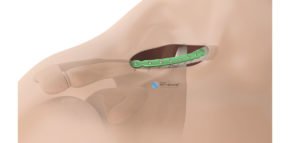Clavicle fractures are extremely common and their non-surgical treatment by simple immobilization has long been the rule.
This non-surgical treatment remains quasi-systematic in children and young adolescents who present with slightly displaced fractures and who, moreover, benefit from the potential for bone remodeling linked to growth.
In adults, this orthopedic treatment most often results in the formation of a malunion, i.e. a consolidation of the clavicle with a shape that is not the original one. These malunions are often well tolerated except when there is significant clavicular shortening which can alter the mobility of the arm in certain positions. Sometimes, the bone callus can be very bulky and compress the neighboring vascular and nervous structures and cause functional discomfort in the upper limb.
So when should you operate?
Surgical treatment by screwed plate has shown its superiority over orthopedic treatment with a reduction in the risk of non-union, better anatomical restitution of the clavicle, better functional outcome and more satisfied patients, including aesthetically.
Surgical treatment is the only one to restore a physiological anatomy but it exposes to more complications than orthopedic treatment which still has its place in adults.
Even if there is no absolute consensus on the treatment of clavicle fractures, it is classically accepted that surgical treatment should be proposed in the event of:
- Fracture with skin opening
- Fracture where one of the fragments threatens the skin
- Fracture with nerve or vascular compression
- Multi-fragmentary fracture which exposes to a greater risk of non-union
- Displaced fracture with significant shortening of more than 15 mm
- Need for anatomical reconstruction of the clavicle in an athlete or a manual worker
Discover the operations linked to this article:

Fractures of the clavicle
Fractures of the clavicle commonly occur after a fall on the shoulder. For a long time, these fractures were simply immobilised, even if the fracture was greatly displaced. In adults, some fractures can heal poorly or result in poor functional outcomes if the clavicle heals in a non-anatomical position. Even if immobilisation alone can be proposed in most cases, surgical treatment with a plate ensures better healing and improves the anatomical, functional and aesthetic outcome.

